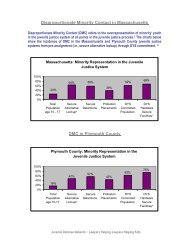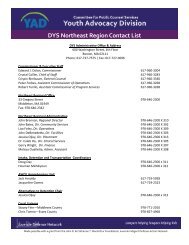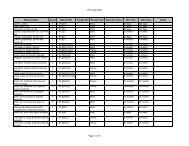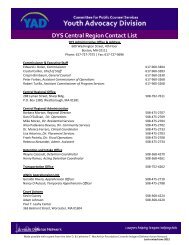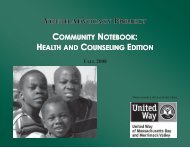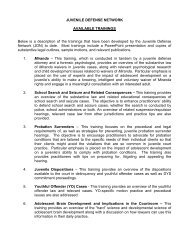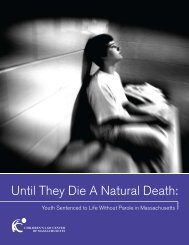States rethink 'adult time for adult crime' - the Youth Advocacy Division
States rethink 'adult time for adult crime' - the Youth Advocacy Division
States rethink 'adult time for adult crime' - the Youth Advocacy Division
You also want an ePaper? Increase the reach of your titles
YUMPU automatically turns print PDFs into web optimized ePapers that Google loves.
What Makes Teens Tick; A flood of hormones, sure. But also a host of struct...plain <strong>the</strong> behaviors that make adolescence so exciting--and so exasperating<br />
disorders. Some scientists now believe that ADHD and Tourette's syndrome, which<br />
typically appear by <strong>the</strong> <strong>time</strong> a child reaches age 7, may be related to <strong>the</strong> brain<br />
proliferation period. Though both disorders have genetic roots, <strong>the</strong> rapid growth of<br />
brain tissue in early childhood, especially in regions rich in dopamine, "may set <strong>the</strong><br />
stage <strong>for</strong> <strong>the</strong> increase in motor activities and tics," says Dr. Martin Teicher, director<br />
of developmental biopsychiatry research at McLean Hospital. "When it starts to<br />
prune in adolescence, you often see symptoms recede."<br />
Schizophrenia, on <strong>the</strong> o<strong>the</strong>r hand, makes its appearance at about <strong>the</strong> <strong>time</strong> <strong>the</strong><br />
prefrontal cortex is getting pruned. "Many people have speculated that schizophrenia<br />
may be due to an abnormality in <strong>the</strong> pruning process," says Teicher. "Ano<strong>the</strong>r<br />
hypo<strong>the</strong>sis is that schizophrenia has a much earlier, prenatal origin, but as <strong>the</strong> brain<br />
prunes, it gets unmasked." MRI studies have shown that while <strong>the</strong> average teenager<br />
loses about 15% of his cortical gray matter, those who develop schizophrenia lose as<br />
much as 25%.<br />
WHAT'S A PARENT TO DO<br />
Brain scientists tend to be reluctant to make <strong>the</strong> leap from <strong>the</strong> laboratory to real-life,<br />
hard-core teenagers. Some feel a little burned by <strong>the</strong> way earlier neurological<br />
discoveries resulted in Baby Einstein tapes and o<strong>the</strong>r marketing schemes that<br />
misapplied <strong>the</strong>ir science. It is clear, however, that <strong>the</strong>re are implications in <strong>the</strong> new<br />
research <strong>for</strong> parents, educators and lawmakers.<br />
In light of what has been learned, it seems almost arbitrary that our society has<br />
decided that a young American is ready to drive a car at 16, to vote and serve in <strong>the</strong><br />
Army at 18 and to drink alcohol at 21. Giedd says <strong>the</strong> best estimate <strong>for</strong> when <strong>the</strong><br />
brain is truly mature is 25, <strong>the</strong> age at which you can rent a car. "Avis must have<br />
some pretty sophisticated neuroscientists," he jokes. Now that we have scientific<br />
evidence that <strong>the</strong> adolescent brain is not quite up to scratch, some legal scholars<br />
and child advocates argue that minors should never be tried as <strong>adult</strong>s and should be<br />
spared <strong>the</strong> death penalty. Last year, in an official statement that summarized<br />
current research on <strong>the</strong> adolescent brain, <strong>the</strong> American Bar Association urged all<br />
state legislatures to ban <strong>the</strong> death penalty <strong>for</strong> juveniles. "For social and biological<br />
reasons," it read, "teens have increased difficulty making mature decisions and<br />
understanding <strong>the</strong> consequences of <strong>the</strong>ir actions."<br />
Most parents, of course, know this instinctively. Still, it's useful to learn that teenage<br />
behavior is not just a matter of willful pigheadedness or determination to drive you<br />
crazy--though <strong>the</strong>se, too, can be factors. "There's a debate over how much<br />
conscious control kids have," says Giedd, who has four "teenagers in training" of his<br />
own. "You can tell <strong>the</strong>m to shape up or ship out, but making mistakes is part of how<br />
<strong>the</strong> brain optimally grows." It might be more useful to help <strong>the</strong>m make up <strong>for</strong> what<br />
<strong>the</strong>ir brain still lacks by providing structure, organizing <strong>the</strong>ir <strong>time</strong>, guiding <strong>the</strong>m<br />
through tough decisions (even when <strong>the</strong>y resist) and applying those <strong>time</strong>-tested<br />
parental virtues: patience and love.<br />
--With reporting by Alice Park/New York<br />
INSIDE THE ADOLESCENT BRAIN<br />
The brain undergoes two major developmental spurts, one in <strong>the</strong> womb and <strong>the</strong><br />
second from childhood through <strong>the</strong> teen years, when <strong>the</strong> organ matures by fits and<br />
starts in a sequence that moves from <strong>the</strong> back of <strong>the</strong> brain to <strong>the</strong> front<br />
BRAIN AREA<br />
DESCRIPTION / DUTIES<br />
file:///L|/JDN/Brain%20Resources/Brain%20Developmen...iling%20Packet/8.%20What%20Makes%20Teens%20Tick.htm (6 of 8)8/16/2006 4:44:18 PM





